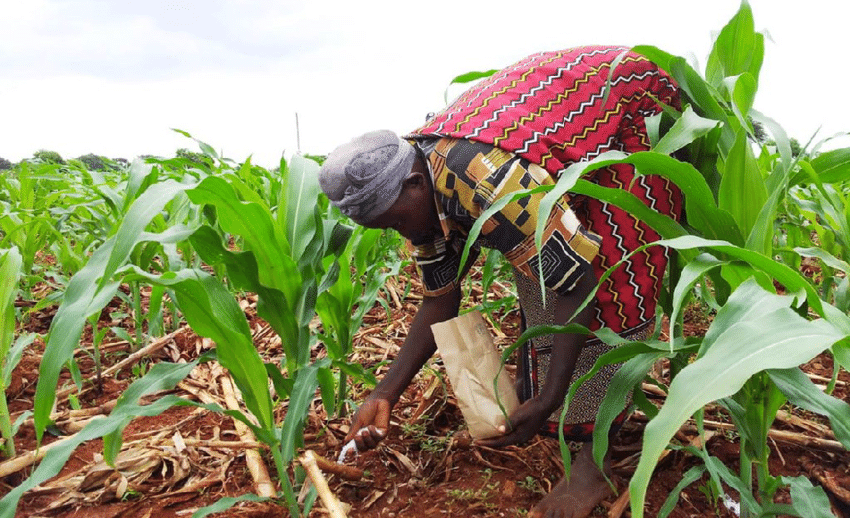
Soil
The four most crucial soil characteristics to take into account when producing maize are texture, structure, pH, and fertility.
Texture
- Sandy clay loams and heavier soils with 10% to 30% clay content are ideal for growing maize. Heavy textured, well-drained soils (sandy clay loams and heavier). Reduced soil aeration and waterlogging both lower corn production.
- Soils with a lighter texture and an appropriate environment require proper fertilizer application.
pH
- For growing maize, the ideal soil pH range is 5.5 to 6.5; it should not fall below 4.5 for light-colored, pale-textured soils and 5.0 for red or heavy soils.
- Lime must be added to the soil to raise the pH if it is below 5.5. Either during the time of land preparation in September or October or during the winter plowing that is carried out in April or May, the lime is added to the soil. Although it is typically used mainly for strengthening soil structure, compost can also be added to the soil to change the pH.
Liming
Periodic laboratory soil testing is used to assess the requirement for liming. The following sums should never be exceeded at once:
| Soil texture | Lime (kg/ha) |
| Light | 600 |
| Medium | 1000 |
| Heavy | 2000 |
After winter plowing, broadcast a disc deep enough to react with the top 30 cm of the soil before planting. Strongly acidic soil requires relatively large applications; half to two-thirds should be administered during the first season, and the remaining third during the second season. Apply modest amounts of lime to the soil’s surface (one bag for every bag of AN applied) as part of conservation tillage. Ideally, do this every year before the rains or irrigation, then use a form of tillage like rip-on-row.
Fertilizer Requirements
Average NPK Requirements for Certain Soils (for high rainfall/ irrigation)
| Fertilizer Nutrients | SFL – Good | SFL – Medium | SFL – Poor |
| *N | Upto 100 | 100-160 | 160-200 *(reduced by about 1/2 dry areas) |
| P2O5 | 30-50 | 50-70 | 70-90 |
| K20 | 20-30 | 30-50 | 50-70 |
- Requirements for marginal areas are dependent on soil type and weather.
Fertilizer rates
- Sending soil samples for analysis is advisable before beginning any agricultural scheme. To be able to pinpoint the precise N, P, and K requirements of the soil, regular (every 4–5 years) soil study is required.
- Samples of the soil must be taken between 15 and 20 cm deep for analysis. According to the fertility state shown by the soil study, crop history, and anticipated yield, the fertilizer program must be changed.
General recommended fertilizer rates according to Natural Farming Region (NFR)
| NFR | Base dressing fertilizer | Top dressing fertilizer | ||||
| Compound D/Maizefert | Ammonium Nitrate (AN) | Urea | ||||
| Kg/ha | Bags/ha | Kg/ha | Bags/ha | Kg/ha | Bags/ha | |
| I – III | 300 – 400 | 6 – 8 | 300 – 350 | 6 – 7 | 225 – 265 | 5 -6 |
| III | 250 -300 | 5 – 6 | 200 – 250 | 4 – 5 | 150 -190 | 3 – 4 |
| IV – V | 200 – 250 | 4 – 5 | 150 – 200 | 3 – 4 | 115 – 150 | 3 |
Time of application
- All of the P, K, and micronutrient requirements are typically met by applying compound fertilizers before or during planting, while the remaining 2/3 of the N is applied as a top dressing in the form of ammonium nitrate or urea.
- At 4-6 weeks after planting, or at maize knee height if applied once, top-dressing fertilizer is advised. The top dressing can be separately applied in sandy soils and/or with high rainfall, which increases leaching. The first half can be administered four to six weeks after planting, and the last half eight weeks later.
- Deficits in secondary (sulfur, calcium, and magnesium) and minor/trace elements (zinc, copper, boron, and molybdenum) need to be tracked and addressed.
Methods of fertilizer application:
- banding in plantation rows and,
- broadcasted. Since fertilizer is concentrated close to the plant roots, banding is typically more effective than broadcasting.

Other soil nutrient replenishing methods
These include natural fertilizers like compost, termite mound soil, and cured animal manure as well as agroforestry and the inclusion of green manure crops such as velvet bean, cowpea, and sun hemp.



















Leave a Reply